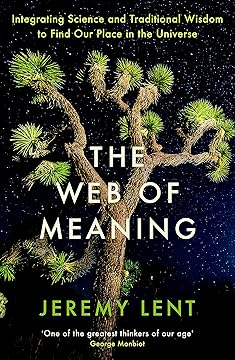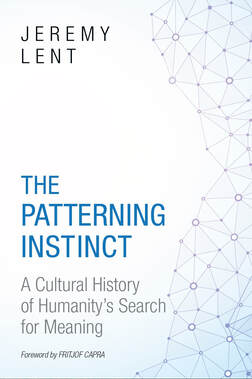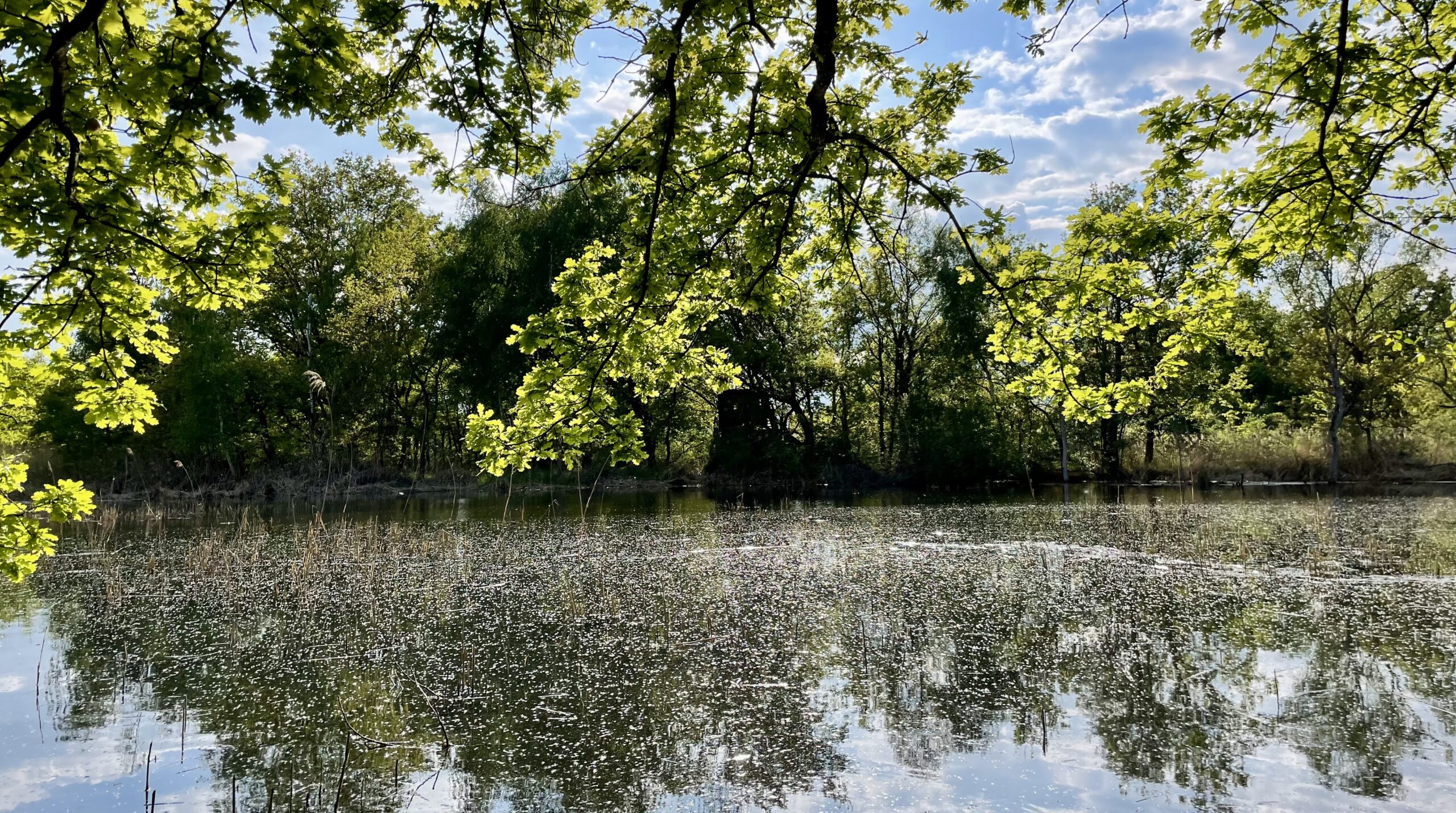The web of life
In his book “The Web of Meaning”, Jeremy Lent describes a conversational situation we’re probably all familiar with; a “speech” we’ve all heard in some form or another: “You’ve probably heard it many times. Maybe even given it. Every day around the world, innumerable versions of it are delivered by Someone Who Seems to Know what they’re talking about.“
At a family gathering, for example: “It’s tea-time, and a few of us are gathered around, talking about the state of the world. Someone comments on what’s wrong with our system and how things could be so much better (…) “Let’s face it,” Uncle Bob declares to the group, “it’s a dog-eat-dog world out there. Every man for himself. For all your ideas about making the world a better place, when it comes down to it, everyone’s just interested in their own skin. That’s the way all of nature works. That’s how we’ve been programmed.”
At its core, according to Jeremy Lent, this message is being passed on: humans are selfish individuals. Selfish genes are the driving force of evolution. Nature is simply a highly complex machine, and human ingenuity has largely figured out how it works. – How did we come to see and experience the Earth and life this way: as things, and as resources to be exploited? So that we even speak of “human resources” that can become capital? Our orientation toward relying primarily on science and technology provides us with progress and comfort, but we lose sight of what is meaningful and valuable for a good life.
From genetic engineering to geoengineering, we treat nature like a machine. This understanding is deeply rooted in Western thought. We describe the complex, emergent processes in the body as “regulatory mechanisms,” “genetic mechanisms,” and “reproductive mechanisms”; we refer to our brains as “hardware”- as if computer programs were running inside us.
Jeremy Lent, whom George Monbiot (The Guardian) calls “one of the greatest thinkers of our time,” sees himself as an author and integrator. He investigates the underlying causes of our civilization’s existential crisis, and explores pathways toward a life-affirming future.
The theory of the “selfish gene”
In his book “The Web of Meaning,” Lent addresses the mechanistic narrative and its far-reaching consequences for our society. Richard Dawkins, British evolutionary biologist and popular science author, has had a major influence with his theory of the “selfish gene”:
„In a nutshell, the underlying story goes something like this: all organisms in nature are simply vessels for the replication of the selfish genes that control us. As such, all living entities – including humans – are driven to compete ruthlessly to pass on their genes. This struggle for reproduction is the underlying engine of evolution (…) human society should be similarly organized, which is why free-market capitalism has been so successful in dominating all other socioeconomic models.“ Jeremy Lent in “The Web of Meaning”
Dawkins argues that in order to overcome our selfish genes, we must educate ourselves to be generous and altruistic – since we are selfish by nature. Although the idea of the “selfish gene” is still present in society, it is now considered outdated and disproven.
Epigenetics – Nature’s color palette
Today, genetic makeup is viewed more like an artist’s palette: It’s available, but of course, it doesn’t shape the painting. Epigenetics studies the cellular processes that influence gene activity.
Lent cites a vivid example of epigenetic influences: Some locusts, harmless, well-camouflaged loners, transform under certain circumstances within a very short time into aggressive swarms of insects that invade and devour entire regions. The same DNA, through epigenetic influences, leads to completely different behaviour in the locusts and – because they suddenly eat different, poisonous plants – to a different appearance with a yellow warning color.
The idea that DNA determines our behavior has now been refuted. Jeremy Lent describes it like this: “Theorists offer a view of evolution as a series of complex, interlocking systems, where the gene, organism, community, species and environment all interact with each other in a variety of ways over different time frames. And regarding our intrinsic human nature, a new generation of scientists has pointed to our ability to cooperate, rather than compete, as our defining characteristic.
This is a crucial discovery, which has become a mainstay of modern molecular biology but has not yet made it into broad public consciousness. It means that the relationship between genes and the organism is not one way but circular. DNA can’t do anything by itself – it only functions when certain parts of it get switched on or off by the activities of different combinations of proteins, which were themselves formed by the instructions of DNA. This process is a vibrant, dynamic circular flow of interactivity.“
So, if we take a closer look at these processes and phenomena, it becomes even clearer how absurd it is to equate organisms with machines: “A machine is static until switched on, and may be switched off without ceasing to exist. Organisms do not have an off switch. The very existence of an organism is, from beginning to end, one unceasing flow and exchange of matter and energy. For it to stop, even for an instant, would mean immediate death. You can leave your computer in an office and return a month later and start using it again. But if you accidentally leave your hamster there, you will not have a hamster for very long.” Iain McGilchrist, “The Matter with Things : Our Brains, Our Delusions, and the Unmaking of the World”, 2021.
Not only are we fully in nature, but nature is fully in us; we see that humans are not separate or solitary actors in the world, but immersed in, driven by and in touch with the environment. Interdependence means more than just interaction; it’s much more our very constitution: We onlycome into being through interaction with our environment.
Even our DNA doesn’t belong only to us
Jeremy Lent delves even deeper into the interconnectedness of life with the following description of the cells we are made of:
„The earliest life consisted of single cells called prokaryotes, which are very similar to the bacteria that have thrived on Earth ever since. (…) Not much happened to write home about for another billion years or so, other than a particular kind of bacterium started proliferating which released oxygen into the environment as part of its metabolism. This new addition to the atmosphere was toxic to many early cells, causing the first mass extinction event on Earth. It was around then that a new type of cell arrived on the scene. Called a eukaryote (Greek for ‘true kernel’), this cell contained a nucleus that housed all its DNA material.
Eukaryotes found a novel way to get their nutrition: they took advantage of their more flexible cell walls to engulf other bacteria and ingest them, breaking their parts down to use as food. Except that something rather strange happened – and probably more than once. A eukaryote engulfed a prokaryote, and instead of digesting it, they started working together. This particular prokaryote was a tiny powerhouse, specialized in taking oxygen – now ubiquitous – and turning it into energy. Called a mitochondria, it formed a relationship with eukaryotes that could lay claim to be the most successful partnership on Earth. Every organism that you see around you – every plant, every insect, every animal – is comprised of eukaryotic cells containing hundreds, and sometimes thousands, of mitochondria within them (in plants they’re called plastids), producing the energy that allows the cell to go about its business. To this day, mitochondria still carry their own DNA with them, which they use to replicate separately from the rest of the cell.“
The cooperation initiated between eukaryotes and mitochondria is viewed by many biologists as one of the most important events ever to have occurred in the history of life on Earth.
“Life conquered the world not through struggle, but through interconnectedness.” Evolutionary biologist Lynn Margulis
Cell networks form our organs, and they work together in an extremely harmonious way: no competition or selfish behavior: a selfish liver competing with the heart or lungs would mean a swift death. Of course, there’s no question that competition and the struggle for survival also play a central role in the drama of life. How can we reconcile this with the forces of cooperation?
An ecosystem arises from organisms interacting in a complex interplay of both competition and cooperation: a harmonious dance of life. In fact, the creative tension that arises from this is itself a driving force of evolution. And: “Maybe there is another way to describe the elegantly complex interweaving of natural processes that comprise an ecosystem: harmony.” Lynn Margulis
Not matter, but relationship creates meaning
So, what does all this have to do with the meaning we seek in life?
Just as music is an emergent, unexpected, newly occurring, moment-to-moment phenomenon between musicians and listeners, so is meaning an emergent phenomenon and experience that arises from encounters, interactions, the experience of connection and deep contact.
To the question “What am I?”, which we all ask ourselves at some point, Lent gives the surprising answer: I am a robust pattern of self-organizing cooperation. He describes what this means as follows:
For example, let’s think of a photo of ourselves as a small child. We know that’s who we are, perhaps we even have the memories of it. And yet, everything that child is made of, every cell in that child is different from the cells of the current self.
There are some cells in the body that actually remain in our body throughout our lives, but even these cells are constantly changing their components. What connects us to this small child are the principles of organization, the way the elements relate to one another. This creates the coherence of identity in our experience. This ensures that the memories we have remain stable. Our identity remains connected to this small child through the interactions between the elements. The relation between the individual elements is, in this respect, more important than the elements themselves.
From there, Lent develops his understanding of sensemaking and meaning: In complex systems, an increasing number of connections arise, and this creates new meanings – for example, when neurons connect to enable consciousness. When organisms connect to create an ecosystem. When words combine to form language, creating meaning. When individual notes combine to form a melody. And so on… Meaning and meaningfulness thus arise when we create new connections.
The physicist Nils Bohr also described that “a ‘thing’ is only a ‘thing’ in the ‘context’ of relationship. Change the relationship, and the ‘thing’ changes. In other words, there are no ‘things’, only entanglements, only relationships – and an entanglement isn’t a tethering of already determined essences. It is ‘an’ ongoing promiscuity that makes thingness possible, the waltz of a thousand im/possibilities, the world melting into and making love with itself. “
Jeremy Lent again: “So we could also talk about life as interconnected, coarising, actively selforganised processes, with rhythm and harmony, expressing a sense of wholeness, inextricably linked with values, meaning and purpose – each leading separately and together, to the phenomenon of self-realisation.”
And: “Basically, everything we do in life creates ripples that affect everything else in the universe, leading to this fundamental principle of the ultimate interconnectedness of everything in the cosmos. So we exist in an ocean.”
We highly recommend both of Jeremy Lent’s books, as well as the articles on his website and his lectures on YouTube.



